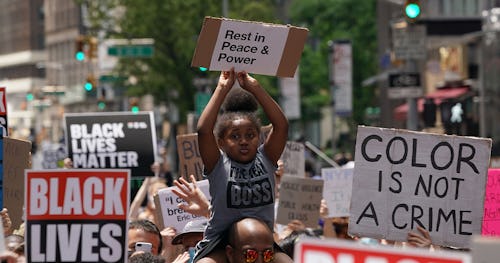How to Talk to Young Kids About Racism and Racial Bias
Posted by admin on

The conversation about racial bias taking place in America right now isn’t really a conversation. It’s more of a shouting match. And there’s a reason for that: The idea of racial bias inflames long-standing social tensions and the insecurities of white people who’d prefer to believe that they’re playing on a level field. Both research and history indicate that this isn’t so. And both research and history indicate that talking to children, specifically young children, about racism and racial bias can help them better contextualize not only the news cycle – all those weird words they hear dripping from the television – but also the experience of existing in a less than perfect union.
“It is essential that all parents speak to their children about race, the importance of compassion, and empathy to truly make this world a better place for us all,” explains developmental and behavioral expert and American Academy of Pediatric fellow Dr. Eboni Hollier. “We should not pretend that racism does not exist.”
Hollier notes that efforts to protect kids from issues of racial bias does both children and their community a disservice. Children not being engaged in a conversation about race may come to believe that the subject is taboo. Silence breeds silence, inaction, indifference, and ignorance. So it’s important that parents do make the effort to talk about the differences between peoples’ experiences, acknowledging that those differences do exist and pointing out that this is all the more reason to treat everyone with respect. It’s also important that they understand the whole thing is pretty complicated and kids are likely to have some follow-up questions.
“In general, keeping the lines of communication open between parents and children is essential when discussing race,” explains Hollier.
She also notes that, even before kids are verbal, parents can communicate their views on racial bias through modeling appropriate behavior. Parents who interact with and talk about people of other races with kindness and empathy teach children behaviors that combat racial bias. Having a diverse group of friends doesn’t hurt either, though there can be regional and social barriers that make that a bigger ask (keeping friends when you’re a new parent is a big ask in and of itself). Regardless, kids pick up on what parents do, even before they are able to hold a conversation. But once they’re in school, things change significantly.
“They begin to have more logical, flexible, and organized thoughts,” explains Hollier. “As such, parents may better reason with them.” But Hollier notes that reasoning does not mean lecturing. It’s about having a conversation.
The Five-Pronged Approach to Talking Race With Kids
- Keep the lines of communication open between parents and children during and after discussions of race. Children will likely have questions.
- Avoid pretending that race and racism don’t exist. Acknowledge that race does exist and point out that this is all the more reason to treat everyone with respect.
- Teach children behaviors that combat racial bias by modeling good behavior with people of other races.
- Use the news or other real-world issues of racial bias to jumpstart a conversation involving simple, personal questions.
- Incorporate personal life stories when relevant to have the most effective impact.
“This is also a time when children become more aware of ethnic stereotypes,” Hollier explains. “Children may begin to associate inferior status and superior status of groups based on race and these thoughts may come from their exposure to media or the world around them.”
At this time parents may want to start addressing issues of racial bias in the news, or even out in the world, should something be observed by their kid or themselves. For parents who don’t know how to start the conversation, Hollier suggests it’s as simple as asking a questions like: “What do you think about what is happening?” and “How does that make you feel?”
It’s then a process of listening and answering questions as honestly and openly as possible. The idea is not to solve the problem of racial bias, but rather to show that it’s a conversation that can occur thoughtfully and meaningfully.
Diversity trainer and community organizer Dr. Froswa’ Booker-Drew notes that, for some families, the conversation will be more personal and will draw on the power of life stories. “Starting from your personal experience, your narrative is the most effective,” Booker Drew explains. That might mean being honest about instances where parents have experienced or overcome racial prejudice. It might also mean being honest about bad behavior and family biases. “It’s about owning your experience or your family’s history which is also important. It’s not about sugarcoating the issue.”
Booker-Drew notes that many communities don’t have the luxury of entering gently into conversations about race. Sometimes it kicks down the door, as it did with her own family.
“Our conversation started when a kid in elementary called my daughter the ‘n’ word,” she says. So the dialogue has to be deeply personal and explicit in some cases. Booker-Drew remembers her own father being explicit about what she might face as an African-American girl in the seventies and eighties. “He explained I might encounter people who make a decision about me because I was different,” she says. “He also told me that I would be missing out on something really good if I did that to others.”
Parents are all starting in different places in terms of their own biases and experience, Booker-Drew acknowledges. This, she adds, is a good thing because just as parents can model inclusive behaviors when children are pre-verbal, they can model personal change when their kids are older.
“Showing them growth helps them become better people who fight for those that may not have a voice in your circles,” she says.
